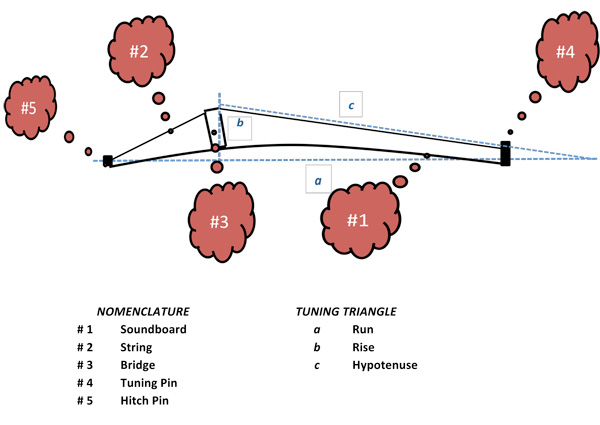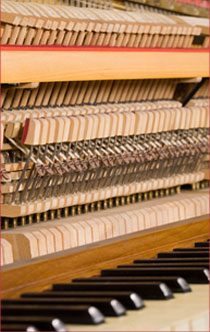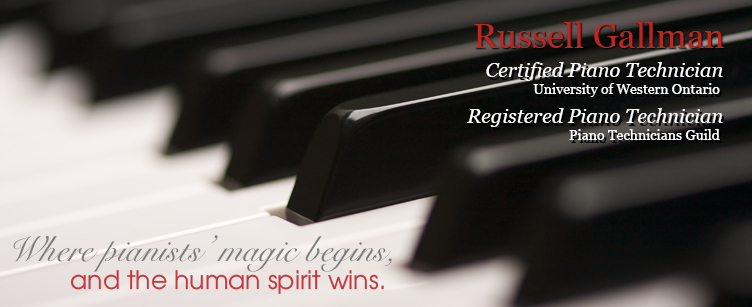FAQs
What does the expression “pitch raise” mean?
How will I know if my piano needs a pitch raise?
Why does my piano go out of tune?
How often should I expect to have my piano tuned?
Is there an optimal place in my home to place a piano?
What does the expression “pitch raise” mean? Why do you do a "pitch raise"?
You may have heard your piano technician use the terms pitch raise and pitch lowering. The expressions actually have dual meanings and functions. From a simplistic view point, your piano may be significantly flat or sharp in pitch position when compared to an A440 tuning fork. Hence, the tuner will adjust the pitch accordingly. However, that characterization is not always sufficient.
The Easy Answer:
The simple response to the question of "Why is a pitch raise necessary?" is this: Pianos need to be in tune in order to tune them.
The More Complex Answer:
The very first thing to be aware of is that pianos are Energy Transfer Systems. The piano tech has to balance an energy load between two relationships - the soundboard and the piano strings. The soundboards are loaded with compression energy and the strings are loaded with tension energy. To achieve a stable and lasting Finish Tune, the soundboard compression and the strings' tension need to be at an approximate A440 load. The industry standard process of achieving this balance is called Pitch Raising. In our industry, each key is assigned a value of 100 cents. In Russell's techniques and practices, the gray zone where a full pitch raise will be required starts at 18 cents flat or sharp. For the range of 3 cents flat to 16 cents flat, he has techniques that he refers to as Adaptive Speed Pitching, and presently he does not apply an up-charge for the additional work in the modified pitching techniques. However, after 18 cents flat, a full pitch raise is unavoidable. Cutting corners may mean that the piano may be out of tune before he even leaves your home on the very first tuning visit. This is a very decent description! If you are a details geek though, please feel free to finish reading this section. Be sure to read the Owner's Risks at the end.
The average residential piano usually has 220 strings that are attached at fixed points. Most concert grand pianos can have up to 240 strings. Let us assume that your piano has not been tuned in ten years. It will most likely be the case that your piano is very flat. In order to bring your piano up to concert A440, the tuner adds tension to each string (i.e. 10lbs per string). The total amount of new tension on the wires can be quite significant.
So you have probably seen a violin. The string is attached at the tail, then passes over the bridge, and then is attached at the tuning peg that tightens the string. How many strings are on a violin? 4. Compare that to a piano though. A piano may have 36 to 39 strings in 12". So each time the string is tightened, pressure is pushing down on the bridge and sound board. For the piano tuner, this means that the sound board will be sinking as tension is applied to the strings. So by the time the tuner is 12" from a previously tightened string, it may already be just a tiny bit flat and out of tune again.
Pitch raise does refer to raising pitch, but more importantly it refers to the procedure that a technician utilizes to pressurize a sound board before a Finish Tuning. In general, pianos behave in predictable ways. Sound boards are engineered and constructed to function like springs under compression and thus find a place of equilibrium against the forces being applied by the music wire. Once the sound board is evenly compressed, the piano will be more likely to hold a fresh tuning. Hence, pitch raise and pitch lowering are important pre-tuning passes and pressurizing techniques used to achieve a reliable, enjoyable, and stable finish tuning.
Bringing pianos up to pitch is not without its risks. Please review Owner’s Risks (Good News and Bad News) and the Piano Tuner’s Disclaimer in the Tuning tab. Also note that pitch raised pianos tend to go out of tune quickly. Keep an ear open. Your technician controls the “tuning pin” end of the string, but time controls the opposite end – the “hitch pin“end. It is not uncommon for a follow-up tuning to be required in 6 months.
How will I know if my piano needs a pitch raise?
New content added for 2020.
Good question, and it seems to confuse and intimidate people. So let's shed some light on the subject and demystify this pitch raising conundrum. The industry standard in the piano tech world is that keys and pitch are measured in terms of CENTS. Just like a $1.00 bill equals 100 pennies or cents, each key on your piano is assigned a metric of 100 cents. Once Russell is set up to begin the tuning process, the first step is to "take the vital signs." In this case, an iPad tuning app known as Tune Lab is used to measure the pitch position in terms of cents on the piano. All the A's are measured and recorded on the Customer Work Order.
Most typically, a residential piano that is tuned once per year may go flat or sharp (depending on the dry air from heaters in January or the arrival of summer humidity by July 4th) by 1 cent to 8 cents. As part of a Basic Finish Tuning, Russell usually performs a technique called Speed Pitching. And normally he only needs to turn approximately 90 tuning pins in order to add a small amount of pressure to the sound board to accommodate the Basic Finish Tuning. And currently, he does not charge for the Speed Pitching. Hence, your starting cost for the tuning visit will be the Basic Tuning. Consequently, this is the most common repeat biz customer tuning cost when the piano is revisited within 24 months for a new Basic Tuning. There are exceptions to this, but Russell tries to honor repeat biz customers with this price level.
Challenges begin to arise when the pitch position being measured by the computer reads -20 cents flat or + 20 cents sharp. The average piano has approximately 220 tuning pins. And each of those pins/strings will need to be turned one time prior to the Basic Tuning to either add or decrease the pressure on the sound board. The measurement range on a 1-pass Pitch raise is 20 cents to 75 cents flat or sharp. Hence, your starting cost for the tuning visit will be the Basic Tune + 1 Pitch Raise. Consequently, this is the most typical New Customer first tuning visit. And the customer is usually advised that the piano may go fuzzy quickly. If it bothers the customer within 6 months, then plan on retuning in 6 months. But on the average, avoid waiting longer than 12 months to schedule a new tuning visit.
A third level of complexity arises with pianos that are 75 cents flat and more. Fortunately, these pianos do not happen too often as they can be painful to work with. On occasion, a piano that is 100 cents flat comes around. 100 cents is one full key flat. This is possible when a piano has missed 30 years of tunings, and/or it has both missed tunings and has been moved multiple times. In this case you will need to budget 2 Pitch Raises + 1 Basic Tuning. And plan on allowing approximately 2.5 hours to do the work. And be advised, that you will need to retune in 6 months. A piano that has missed 30 tunings will go ugly quite quickly.
Hopefully, this info is not overly techie. Feel free to contact Russell if it is too confusing.
Why does my piano go out of tune?
This Frequently Asked Question can be addressed from many angles. There are many reasons that contribute to a piano’s ability (or lack of ability) to hold a tuning. The two most frequently encountered causes of pianos going out of tune are loose tuning pins and sound board movement - expansion and contraction - due to the piano’s environment.The most important contributor to an instrument’s stability is its environment. The western scale began its journey with the ancient Greeks. Not only did they cultivate what we know today as perfect fifths, the Greek philosopher Pythagoras promoted our facility with triangles in what has become known as the Pythagorean Theorem. Before I familiarize you with the importance of triangles in your piano and how they relate to a piano’s stability, let’s first visit a very important piece of wood in the instrument – the soundboard.
The Soundboard –
From a physics concept, your piano is an energy transfer system. As we strike the front end of a key, a chain reaction of events happens in the “gears” which moves a hammer to impact a string. The hammer excites a wave pattern on the string that in turn transfers energy to the soundboard – the piano’s amplifier. The larger vibrating surface area of the board in turn excites the air molecules (more efficiently than narrow strings) at different frequency patterns. With regard to a piano’s tuning, we can imagine that a soundboard “breathes.” Just as our chests rise and fall as we inhale and exhale, our soundboards rise in the presence of humidity, and they fall in the absence of humidity.
The Soundboard & Triangles –
Below is an exaggerated and simplified depiction of a typical soundboard with a bridge and a single string. As you notice, the board is shown with an arch or radius. In a healthy piano this is known as a crown. Typically, the manufacturer has designed a 60’ radius into the construction of the soundboard. The primary triangle shown has labels “a”, “b”, and “c”. For our conversation, “a” is the run of the triangle; “b” will be referred to as the rise; and “c” will be assigned as the hypotenuse. Also, for our discussion, please note that the run of our triangle is typically fixed in the structure of your instrument and will very seldom be altered. We will be exploring the seasonal changes of the rise and hypotenuse that occur.
 The Humid Season Environment –
The Humid Season Environment –Typically in the state of Georgia, it is not unusual to see the humidity return beginning in the month of May. Wood acts like a sponge in the presence of moisture. As the soundboard in your piano begins to retain the moisture in the atmosphere this causes the crown (the hump) to rise upwards. As you probably recall from Algebra days, as the rise of a triangle increases, so too will the hypotenuse increase in length. As the hypotenuse grows in length, the tension on the string also increases. Pitch goes up. In Georgia, our summers can be saturated with 80% relative humidity and sometimes more.
The Dry Season Environment –
In contrast to the thick, humid days of summer that we can cut with a knife, we see just the opposite during the fall and winter months. When one can see Stone Mountain in the distance on an October afternoon, then pianos will soon be feeling the effects as well. The dry months present a double challenge for your piano. Cooler air holds less moisture, and we turn on the heaters in order to warm our bodies. Again this mobilizes the tuning triangles. As the spongy soundboard begins to part with its moisture, the hump goes down, and the rise of the triangle begins to decrease. Less rise means shorter strings and less tension on the wire. Hence, the pitch goes down. Winter of 2010 not only produced record low temperatures; the relative humidity at my residence was as 16%.
How often should I expect to have my piano tuned?
A proper response to this question is contingent upon how the instrument is being used. For example, the performance grand pianos in the concert venues of the university where I received my training were tuned 3 times per week during the active recital season. In contrast, the average practice room upright pianos would be tuned at least 3 times per season.
The Tuning Envelope and Piano Health –
The tuning envelope refers to the amount of pitch change that occurs between tunings. The less the change, the more stable a tuning will be and the greater the longevity the owner will realize on subsequent tuning visits. Hence, it is important to schedule tunings often enough to keep the tuning envelope as narrow as possible. If you want to save money, then don’t tune. But be prepared. Getting caught up can be costly. My Base Tuning Fee only applies to the first 1.5 hours of a tuning visit. Beyond 1.5 hours means that more effort and passes are being made so the tuning will hold. Hence, an additional fee will be assessed to your tuning visit. In addition, one or more tuning visits may be required in order to re-stabilize a piano. Why? Because the piano technician controls the tuning pin end of the string, but time controls the other end that equalizes during heavy playing. Finally, pianos that are permitted to significantly drop in pitch are at increased risk of string and plate breakage. The responsible course of tuning maintenance: Keep it close.
Residential Pianos –
For most pianos in homes, the owner is advised to schedule tunings no less than once per year. Bi-annual tunings are the most recommended, and will be required as a student’s sense of pitch develops. Discerning artists typically have their pianos tuned 4 times per year.
Institutional Pianos –
Please visit the Institutional Piano Care segment of this site for recommended practices.
Is there an optimal place in my home to place a piano?
Pianos make beautiful center pieces in our homes. However, there are things to consider when locating a piano in the home. Temperature and humidity changes will play an enormous role in a piano’s individual life cycle and in its ability to hold stable tunings.
- Try to avoid placing your instrument too close to the floor and wall vents of your home’s heating and air conditioning system. The heating especially can cause damage to a piano’s structural integrity.
- Try to avoid placing the piano in a location of direct sunlight as this too will shorten both the life of the instrument as well as blow out any tuning services that are provided.
- Try to avoid placing the piano on exterior walls.
- Try to avoid placing the piano underneath windows or even nested within bay windows.
contact@PrimePianoServices.com


